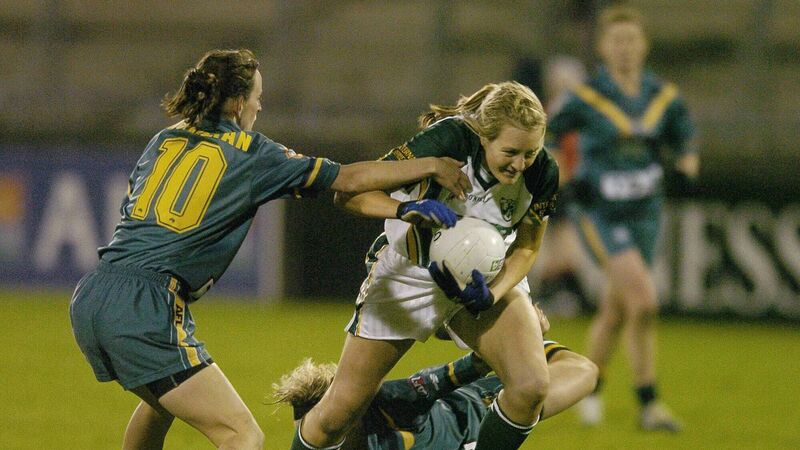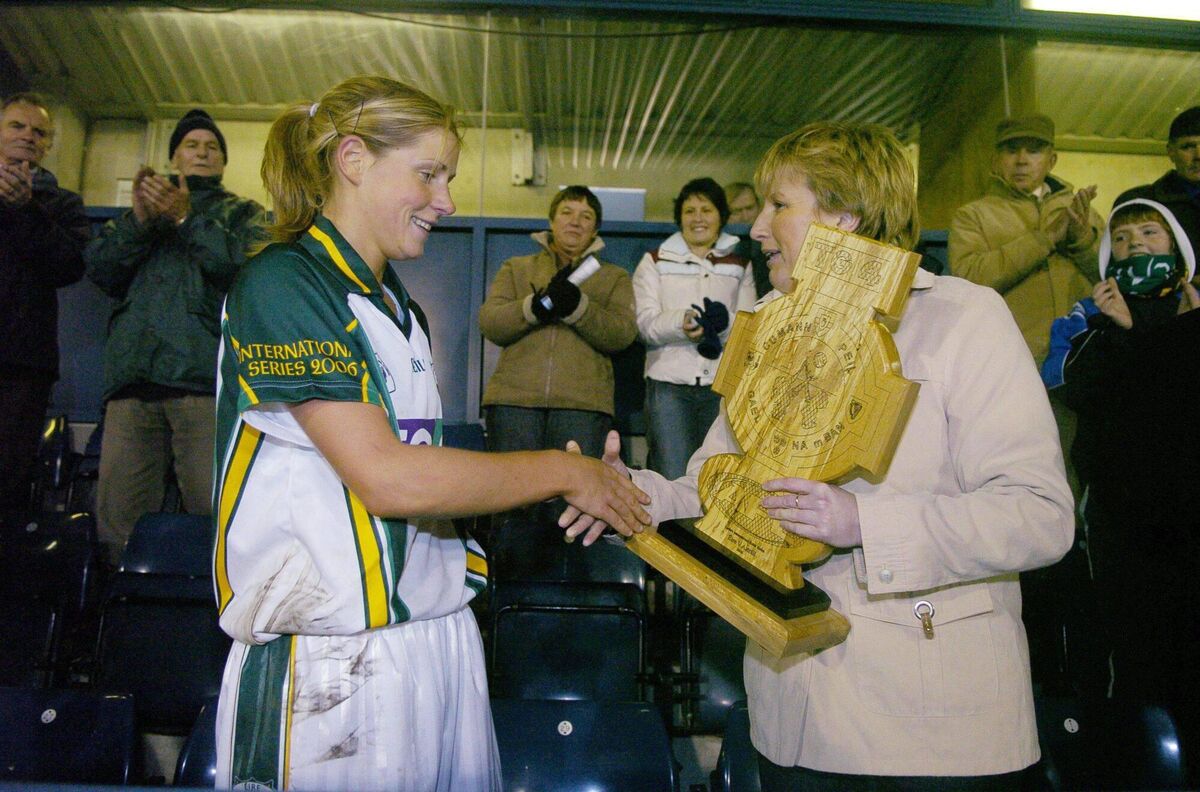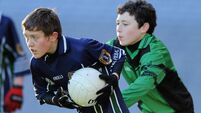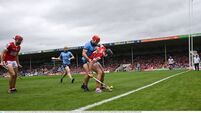The short-lived ladies' International Rules series: ‘It was the most bizarre thing ever. We went back to zero and still hammered them’

Ireland’s Mary Sheridan in action against Shannon McFerran, 10, and Kerryn Stephens, Australia, during the second Ladies' International Rules Series Test at Parnell Park, Dublin. Pictures: Brendan Moran / Sportsfile
Micheál Ó Domhnaill would never get away with it during a GAA match but he had that licence to be radical this weekend 15 years ago.
At the end of the third quarter of a ladies' International Rules game between Ireland and Australia in 2006, the renowned TG4 presenter found himself talking to his audience at home while running after a referee to conduct a live TV interview in the middle of Parnell Park.
When Ó Domhnaill caught up with both referees Declan Corcoran and Cony Vardouniotis, he asked Vardouniotis to explain to him, and to everyone at home, why Ireland just had their entire score of 42 points wiped from the scoreboard with less than half the match still to play.
“When someone is given a yellow card, they have to go off for 10 minutes and they’re not to be replaced,” said Vardouniotis to a live TV audience.
“An Irish girl came on to the field, so they had an illegal player. An interchange crew told her not to go onto the pitch and she did, against their advice. The law is that if a team has an illegal player, they lose their entire score up to that point.”
TG4 have been breaking boundaries with their coverage for decades but the footage that evening was astonishing for its immediacy throughout the controversy. After Cora Staunton was sin-binned two minutes into that third quarter, the match continued for another three minutes before a conclave of officialdom formed in the middle of the pitch and Corcoran, who was mic’d up to the TV, could be heard organising a head-count with the Irish players within earshot.
“We want to count the players,” he said. “Line up either side of the halfway line.”

At that stage, Vardouniotis made her way over to Nicole Graves, the Australian manager, where they spoke for close to a minute, before Vardouniotis approached the interchange officials, who immediately got up from their chairs behind a table at the side of the pitch. With a mobile TV camera hovering just behind the scrum, the footage captured Vardouniotis delivering the verdict — and what now needed to happen — almost straight into the camera.
The raft of Irish officials were clearly stunned. Then the Australian referee went straight over to the Irish manager, Jarlath Burns. “Coach,” she said, “we’ve had an illegal entry which means you now lose all your points up until this point of the game.”
Burns, with his arms folded, didn’t even blink. He just nodded in agreement. “No problem at all,” he replied calmly, “we’ll start off again from zero.”
When the Ireland manager asked the Australian referee if he could talk to his players, she cut him off in mid-sentence: “No, we have to restart the game.”
Fifteen years on, Burns recalls the incident. “It was the most bizarre thing ever,” he says. “The Australians were almost expecting us to push out against them, but we didn’t. It didn’t matter because they were going to have to get about 200 points to beat us. It was never going to happen. So, we just went back to zero and still hammered them.”
Ireland still won that second test 39-18. A week earlier in Breffni Park, Ireland had thrashed Australia by 134-15. Ireland had 18 different scorers. The lead-up to the first game had been exciting and exhilarating for the players. The build-up to the second match was as damp as wet firewood.
“We were almost asking ourselves beforehand ‘What’s the point in this?” says Burns.
Then during the week, it got a bit nasty because the Australians started complaining about our girls’ tactics. They were saying that they were too rough. We were laughing at it all because they didn’t even come near us.
“There was no physicality in the game, but we were puzzled by how far ahead we were of them. We trained those girls really hard to be ready for it, but it was disappointing because it was no contest.”
The Irish team were more than ready for the Series. The captain Sarah O’Connor from Kerry was an excellent player, but she wasn’t a marquee name in a squad decorated with All-Stars and All-Ireland winners. “I put a load of work into just getting on the panel,” says O’Connor. “I wasn’t expecting anything from it really. I wasn’t even expecting to make the team, but I just kept at it. It was the most effort I put into anything in sport. We were given a programme, but I was training morning, noon and night. We were training really hard with Kerry at the time as well, but it was going to be hard to win an All-Ireland. I was never going to make it in that sense so when this thing came up, I saw it as my chance to get to the top.
“The management were excellent. We were treated really well. There was a massive build-up to the first game because it was all so new. There was such excitement that we were treating it like an All-Ireland final. There were other things that stood out with my county, but that experience was the best for me.”

O’Connor can still vividly recall the moment, and the feeling of elation, when Burns announced she was to be captain. “It was a huge shock,” she says. “The sweat was pouring off me. I definitely wasn’t expecting it, but I was so delighted with the honour.”
O’Connor’s captaincy was a broad reflection of the make-up of the group, and the ladies’ game at that time. Cork had just won their second All-Ireland, but their all-conquering impending crusade was still largely in gestation.
They beat Armagh by one point in the All-Ireland final — and Armagh had gone from Junior football to an All-Ireland senior final in the space of 12 months.
There were only four Cork players on the panel. Fourteen different counties were represented. Twenty-two of the squad of 30 had been nominated for All-Stars that season. “We were playing with the cream of the crop,” says O’Connor. “It was class. We showed our talent in the first game, but the same atmosphere wasn’t there for the second game because, no matter what happened, we knew we had it won.”
The concept — and rules — had been designed and agreed in Singapore the previous March. It was the first, and only, ladies' International Rules Series but, while ladies Gaelic football was taking off here, nobody was sure what the standard was like in the Australian game.
At the time, there were just 19,000 women Aussie Rules players in Australia, which was less than a quarter of the numbers playing in Ireland then. Although the game was being played in all states, there was no national competition for Women’s Aussie Rules. Australia assembled a team consisting mostly of Victorian Women’s Football league players following the women’s Australian rules football national championships. Only six clubs were represented on the squad.
Ireland had a clear advantage with the rules and the round ball, which is what the Australians naturally focused on in reporting on the Series.
“The refusal of the Irish to allow the Australians to tackle reduced the compromise to an almost farcical level,” reported the World Footy News afterwards. “With the only Australian rules being the mark and point posts, this greatly disadvantaged the Australian players and gave a definite advantage to the Irish. The lack of compromise rules could bring the entire exercise into question.”
In response to the humiliation, Ireland offered to play the second test with the Aussie rules ball, but the Australians refused, probably out of pride.
“They were playing a different game but so were we,” says O’Connor.
They were giving out about the ball. They were giving out about our physicality. They were big strong women, some of them were nearly twice as big as us. We were physically fitter than them. They were slow and sluggish.
“We were definitely up for it, but we were half their size. We were going into tackles that we normally wouldn’t go into in football. We weren’t going to hold back but we definitely weren’t overly physical. We didn’t pull out, and we weren’t going to either. I just thought they’d be much better.”
The whole profile around ladies Aussie Rules back then was really low. When Australia’s best and most supported women’s league, the WVFL (with 16 clubs and three divisions), staged their Grand Final in 2006, there was less than 1,000 supporters at the Western Oval in Melbourne. As a result, the Australian ladies found it difficult to secure sponsors for the trip to Ireland. The AFL provided around $10,000 to help cover the cost.
Aussie Rules ladies’ football is a totally different beast now though. Since the AFLW kicked off in 2017, the league has expanded from eight to 14 teams. In August, the AFLW announced their expansion plans which now boasts all 18 existing AFL clubs, with an extra licence awarded to four extra clubs — Essendon, Hawthorn, Port Adelaide, and Sydney.
An 18-team professional competition for women is a huge step towards equality and greater inclusion but the numbers have backed up the grounds for expansion; participation figures in the sport have doubled in the five years of the AFLW. A sell-out crowd of more than 53,000 attended the AFLW’s Adelaide-Carlton Grand final in 2019.
The influx of so many Irish players — 14 were involved this year, with 14 again contracted for 2022 — has added to the attraction of the AFLW for Irish supporters, with TG4 showing a plethora of games during the season. Orla O’Dwyer (Tipperary and Brisbane Lions) and Ailish Considine (Clare and Adelaide Crows) have both won Premiership titles.
With such a connection between both codes now, another Series would be far more attractive, and guaranteed to be way more competitive. “Back then, we were convinced that this was the start of something that would end with us getting to Australia the following year,” says Burns. “But it never transpired because we were so far ahead of them.”
In her post-match interview with Ó Domhnaill after that second test, Graves admitted there was a gulf between the sides. But she also said that the Australians had learned a lot from the experience and Graves was already talking about redressing what had just happened.
“We’d like to host them back in Australia next year in good weather and on hard pitches,” she said. “And then see how it goes. I definitely think there is the potential there to continue this Series.”
The environment would be much more conducive now but Burns sees a bigger picture around expanding the international concept, especially in the context of modern women’s sport.
“Ladies Gaelic football seems to be developing easier in a lot of countries,” says Burns. “I was over at the Asian games in Thailand in 2017 and the ladies competition was won by a team from South Korea which was made up of all South Korean girls who couldn’t speak English. I remember watching them thinking ‘Oh my God, look at how they are interpreting our game.’
“There is incredible scope for the ladies’ game. There is also a huge resurgence in ladies sport. Just look at the All-Ireland final this year and the brilliant match between Dublin and Meath. We’re in very exciting times for ladies Gaelic football.”
With such a connection now between ladies Gaelic football and the AFLW, the time could be ripe again in the near future for a much more competitive ladies International Rules Series. And maybe some more bizarre TV viewing.

Unlimited access. Half the price.
Try unlimited access from only €1.50 a week
Already a subscriber? Sign in
CONNECT WITH US TODAY
Be the first to know the latest news and updates













